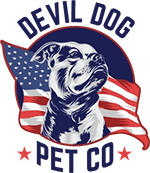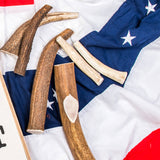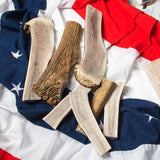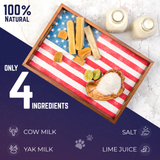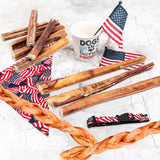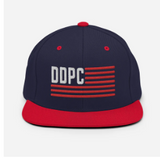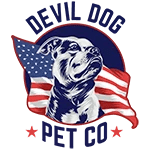Your dog's safety comes first—always. When you're standing in the pet store aisle staring at those gleaming elk antler chews, you're probably wondering if they're actually safe for your four-legged battle buddy. The short answer? It's complicated, and most veterinarians have serious concerns.
Key Takeaways
- Your dog's safety should always be the top priority when choosing chews.
- Elk antler chews may appear appealing but come with potential risks.
- Most veterinarians have significant concerns about the safety of antler chews.
- The safety of antler chews for dogs is a complex issue without a simple answer.
Table of Contents
- What Are Antler Chews and Why the Controversy?
- Understanding Different Types of Antler Chews
- Fact #1: Dental Fractures Are the Primary Veterinary Concern
- Fact #2: Choking and Intestinal Blockages Present Real Dangers
- Fact #3: Most Dogs Are Not Suitable Candidates for Antler Chews
- Fact #4: Proper Supervision and Sizing Are Non-Negotiable
- Fact #5: Safer Alternatives Provide Better Risk-Reward Ratios
- Fact #6: Veterinary Consensus Strongly Opposes Routine Antler Use
- Fact #7: Informed Decision-Making Requires Honest Risk Assessment
- Conclusion: Let Evidence Guide Your Choices
Quick Answer: Are Antlers Safe for Dogs?
Antlers can be safe for some dogs when used correctly, but they carry significant risks. While naturally shed elk and deer antlers are chemical-free and long-lasting, they're extremely hard and can fracture teeth or cause choking. Most veterinarians recommend safer alternatives, but if you choose antlers, use only with healthy adult dogs under strict supervision, proper sizing, and regular inspection.
Here's the unfiltered truth: antler chews have sparked a heated debate in the veterinary community. Some swear by their natural benefits and durability, while others have seen too many emergency dental surgeries to ever recommend them. As dog owners committed to Extreme Dog Leadership, we need to cut through the marketing hype and examine the science.
This isn't about being overly cautious—it's about making informed decisions based on facts, not feelings. Whether you're considering elk antlers, deer antlers, or split antler chews, understanding the real risks and benefits will help you lead with confidence.
In this comprehensive guide, we'll break down everything you need to know about antler safety, from the veterinary research to real-world experiences. You'll discover which dogs should never touch antlers, how to minimize risks if you choose to use them, and what safer alternatives might work better for your situation.
Ready to separate fact from fiction? Let's dig into the seven vet-backed facts that every responsible dog owner needs to know about antler chews.
What Are Antler Chews and Why the Controversy?
Before we dive into safety concerns, let's establish what we're actually talking about. Antler chews are naturally shed bone extensions from deer, elk, moose, and other cervids—animals that grow and shed their antlers annually as part of their natural cycle.
Unlike horns, which are permanent, antlers fall off every year and regrow. This makes them a renewable resource that doesn't require harming animals. Most commercial antler chews come from wild elk and deer in regions like the Rocky Mountains, where shed hunters collect them each spring.
Key Distinction: Quality antler chews should be naturally shed, not sawed off live animals. Reputable suppliers like Devil Dog Pet Co. source only from wild-shed collections, ensuring ethical harvesting practices.
The nutritional composition of antlers includes calcium, phosphorus, zinc, and other trace minerals—essentially the same building blocks that make up your dog's bones and teeth. They contain no artificial additives, preservatives, or excess fats that can upset sensitive stomachs.
So why the controversy? The issue isn't what antlers are made of—it's how incredibly hard they are. Antlers rank among the hardest natural chews available, which creates both their biggest selling point (durability) and their most significant risk factor (dental damage).
The debate intensified when veterinary dentists began reporting increased cases of fractured teeth in dogs whose owners had switched to antler chews. Emergency veterinarians started seeing more choking incidents and intestinal blockages from antler fragments. What seemed like a natural, healthy choice was sending dogs to the operating table.
This doesn't mean antlers are inherently evil—it means they require a level of owner responsibility and dog assessment that many pet parents weren't prepared for. The controversy exists because there's no one-size-fits-all answer to antler safety.
Understanding this foundation helps explain why veterinary opinions vary so widely, from "absolutely never" to "only under specific conditions." The key is matching the chew to your individual dog's needs, chewing style, and dental health—not following blanket recommendations.
Understanding Different Types of Antler Chews

Not all antlers are created equal. The type of antler, how it's processed, and its source animal significantly impact both safety and suitability for your dog. Let's break down the main categories you'll encounter.
Deer Antlers: Dense and Durable
Deer antlers are typically the hardest and most dense option available in pet stores. White-tailed deer produce compact, solid antlers with minimal spongy interior, making them extremely long-lasting but also the most likely to cause dental fractures.
These antlers work best for moderate chewers who gnaw and scrape rather than bite down with full force. They're often the most affordable option, but that lower price comes with higher risk for aggressive chewers.
Elk Antlers: Size and Variable Density
Elk antlers offer more size variety and often have a more variable density structure. The outer wall remains hard, but elk antlers frequently contain more spongy interior material than deer antlers, especially in larger specimens.
This makes them slightly more forgiving for dogs that tend to bite down hard, while still providing excellent longevity. Elk antlers are often the preferred choice for large breed dogs due to their substantial size options.
Split Antlers: Exposing the Softer Interior
Split antlers are whole antlers cut lengthwise to expose the nutrient-rich marrow core. This processing method serves two purposes: it provides immediate access to the tasty interior, and it theoretically reduces the risk of dental damage by giving dogs a softer surface to work with initially.
Many veterinarians who reluctantly approve antler use prefer split versions because dogs tend to lick and scrape the marrow rather than bite down on the hard exterior. However, once the marrow is consumed, you're left with the same hard outer shell as a whole antler.
Moose Antlers: The Softer Option
Moose antlers have a higher proportion of spongy interior material, making them the softest option in the antler family. They're often sold in slices or splits to maximize access to this softer core material.
While still capable of causing dental damage, moose antlers are generally considered the lowest-risk option for dogs that have proven they can handle antler chews responsibly.
The challenge with understanding antler types is that individual variation exists within each category. A deer antler from a young buck might be softer than an elk antler from a mature bull. This unpredictability is part of what makes blanket safety recommendations so difficult.
Regardless of type, the fundamental safety principles remain the same: proper sizing, supervision, and regular inspection for damage. The antler type simply influences the baseline risk level you're starting with.
Fact #1: Dental Fractures Are the Primary Veterinary Concern
Here's the unvarnished truth that most antler manufacturers don't want to advertise: veterinary dentists report a significant increase in tooth fractures directly linked to antler chews. We're not talking about minor chips—these are often severe breaks requiring expensive extractions or root canals.
The most commonly fractured teeth are the large upper premolars, specifically the fourth premolar (also called the carnassial tooth). This tooth does the heavy lifting when dogs chew, making it particularly vulnerable to the extreme hardness of antler material.
Dr. Brook Niemiec, a board-certified veterinary dentist, has documented cases where dogs fractured multiple teeth in a single chewing session with antlers. The fractures often expose the tooth's pulp chamber, leading to infection, severe pain, and the need for immediate veterinary intervention.
Warning Signs of Dental Fracture: Sudden reluctance to chew, pawing at the face, excessive drooling, visible blood on the antler, or a visible crack line on any tooth. If you notice any of these signs, remove the antler immediately and schedule a veterinary exam.
The hardness factor is measurable and concerning. On the Mohs hardness scale, elk antlers rate approximately 1.5-2, while dog teeth enamel rates around 5. However, the issue isn't just hardness—it's the way dogs apply force when chewing. A 70-pound dog can exert over 200 pounds of pressure per square inch with their molars.
What makes this particularly problematic is that dental fractures from antler chews often occur without warning. Unlike gradual wear from appropriate chews, antler-related fractures tend to be sudden, complete breaks that happen when dogs bite down with full force on an unyielding surface.
The financial reality is sobering. A single fractured tooth requiring extraction can cost $800-2,000, depending on your location and the complexity of the procedure. Root canal therapy, when possible, often exceeds $1,500 per tooth. For dogs that fracture multiple teeth, the veterinary bills can quickly reach $5,000 or more.
This doesn't mean every dog will fracture teeth on antlers, but the risk is significant enough that most veterinary dental specialists recommend avoiding them entirely. The question becomes: is the entertainment value worth the potential for serious dental injury?
Fact #2: Choking and Intestinal Blockages Present Real Dangers

Beyond dental concerns, antler fragments pose serious choking and obstruction risks that can turn a peaceful chew session into a life-threatening emergency. Unlike softer chews that break down into digestible pieces, antler fragments maintain their hard, irregular shapes even after being swallowed.
Emergency veterinarians report seeing dogs with antler pieces lodged in their throats, requiring immediate intervention to prevent suffocation. The irregular shape of antler fragments makes them particularly dangerous—they can become wedged in the throat or esophagus in ways that smooth objects typically don't.
Intestinal blockages from antler pieces present an even more insidious threat. These fragments can travel through the stomach but become lodged in the small intestine, where their hard edges can cause perforation or complete obstruction. Surgery to remove intestinal foreign bodies carries significant risks and costs, often ranging from $3,000-7,000.
The size of the dangerous fragment is often surprisingly small. Pieces as small as a quarter can cause choking in medium-sized dogs, while fragments the size of a golf ball can create intestinal blockages that require emergency surgery.
What makes this risk particularly concerning is that antler pieces don't show up clearly on standard X-rays. Unlike metal objects or certain plastics, antler fragments have a bone-like density that can be difficult to distinguish from normal intestinal contents, making diagnosis challenging and potentially delaying critical treatment.
Prevention requires constant vigilance. Dogs should never be left unsupervised with antler chews, and the antler should be removed as soon as it becomes small enough to fit entirely in the dog's mouth. However, even with supervision, aggressive chewers can break off and swallow dangerous pieces faster than owners can react.
The unpredictability of when and how antlers will break adds another layer of risk. Some antlers develop hairline cracks that aren't visible to the naked eye but can cause sudden fragmentation under pressure. Others may seem solid but have internal stress points that give way without warning.
Fact #3: Most Dogs Are Not Suitable Candidates for Antler Chews
The uncomfortable truth is that the majority of dogs fall into categories that make antler chews inappropriate or dangerous. While marketing materials often present antlers as suitable for "all dogs," veterinary guidance tells a different story.
Puppies under 12 months should never have access to antler chews. Their developing teeth and jaws aren't equipped to handle the extreme hardness, and the risk of dental damage is exponentially higher. Even after adult teeth have erupted, young dogs often lack the jaw strength and chewing technique to safely manage antlers.
Senior dogs represent another high-risk category. Age-related dental wear, weakened enamel, and potential underlying dental disease make older dogs particularly vulnerable to fractures. What might have been a safe chew for a dog at age three can become dangerous by age eight or nine.
Dogs with any history of dental work, including previous fractures, extractions, or crowns, should avoid antlers entirely. Compromised teeth are significantly more likely to suffer additional damage, and the financial and physical costs of repeated dental procedures can be devastating.
Dogs Who Might Handle Antlers
- Healthy adults (2-7 years) with no dental history
- Moderate chewers who gnaw rather than bite
- Dogs who can be supervised 100% of chew time
- Large breeds with proportionally sized antlers
Dogs Who Should Avoid Antlers
- Puppies under 12 months
- Senior dogs (8+ years)
- Aggressive or power chewers
- Dogs with any dental history or small breeds
Aggressive chewers—dogs that destroy typical chew toys within minutes—are particularly poor candidates for antlers. Their tendency to bite down with maximum force rather than gnaw gradually makes dental fractures almost inevitable. These dogs often need the mental stimulation that long-lasting chews provide, but antlers aren't the answer.
Small and toy breeds face additional risks due to the proportional size of available antlers. Even "small" antlers are often too large relative to these dogs' jaw size, and appropriately sized pieces become choking hazards quickly.
Breed-specific considerations also matter. Brachycephalic breeds (flat-faced dogs like bulldogs and pugs) have compromised airways that make choking risks more severe. Breeds prone to bloat shouldn't have access to chews that might encourage rapid consumption of large pieces.
The assessment isn't just about the dog's current state—it requires considering their chewing history, dental health trajectory, and behavioral patterns. A dog that shows any tendency toward resource guarding might swallow dangerous pieces rather than allow them to be removed.
Honest evaluation often reveals that the subset of dogs truly suitable for antler chews is much smaller than most owners initially assume. This doesn't reflect poorly on the dogs—it reflects the inherent risks of an extremely hard, unpredictable chew material.
Fact #4: Proper Supervision and Sizing Are Non-Negotiable

If you decide to proceed with antler chews despite the risks, absolute supervision and meticulous sizing become matters of life and death. This isn't casual monitoring while you scroll your phone—it requires focused attention throughout the entire chew session.
Proper sizing means the antler should be significantly larger than your dog's mouth opening. A common rule is that the antler should be longer than your dog's muzzle and thick enough that it cannot fit between their back molars. However, even correctly sized antlers become dangerous as they wear down.
The supervision requirement extends beyond just watching. You need to actively assess the antler's condition throughout the chew session, looking for cracks, sharp edges, or pieces that might break off. Any sign of damage requires immediate removal, regardless of how much antler remains.
Time limits become crucial for safety. Even with perfect supervision, extended chew sessions increase the likelihood of problems. Many veterinarians who reluctantly allow antler use recommend limiting sessions to 15-20 minutes for first-time users, gradually extending only if the dog demonstrates appropriate chewing behavior.
The challenge is that proper supervision is exhausting and often impractical for busy households. Antlers lose much of their appeal as "long-lasting entertainment" when they require constant human oversight. Many owners discover that the mental energy required for safe antler supervision exceeds the benefit of keeping their dog occupied.
Storage and rotation also demand attention. Antlers should be stored in dry conditions and inspected before each use. Any antler that has been dropped on hard surfaces should be examined for hairline cracks that might not be immediately visible but could cause sudden failure.
The sizing challenge becomes more complex as dogs grow or as antlers wear down. What started as an appropriately sized chew can become dangerous within a few sessions, requiring constant reassessment of the size-to-safety ratio.
Environmental factors matter too. Dogs chewing on hard surfaces like concrete or tile face higher risks than those chewing on carpet or grass. The additional impact from the hard surface can increase the force transmitted to teeth during chewing.
Documentation helps track safety over time. Keeping notes about chew duration, any concerning behaviors, and the condition of the antler after each session can help identify patterns that might predict problems before they become emergencies.
Fact #5: Safer Alternatives Provide Better Risk-Reward Ratios
Smart dog owners recognize that numerous alternatives deliver the benefits of antler chews without the catastrophic risks. These options provide mental stimulation, dental benefits, and long-lasting entertainment while maintaining reasonable safety profiles.
Yak chews represent one of the most compelling alternatives. Made from hardened yak milk, they're fully digestible, last significantly longer than bully sticks, and soften gradually as dogs chew. Unlike antlers, yak chews don't maintain their dangerous hardness throughout the chewing process—they become more pliable with saliva, reducing fracture risks.
Split elk antlers, while still carrying some risk, offer a middle ground for owners determined to use antler products. The exposed marrow provides immediate flavor reward, and the longitudinal cut reduces the likelihood of catastrophic splintering. However, they still require the same supervision and sizing precautions as whole antlers.
Safer Long-Lasting Alternatives
- Himalayan yak chews - digestible and gradually soften
- Frozen Kong toys stuffed with treats
- Benebone or Nylabone DuraChew products
- Thick, high-quality bully sticks
Why Antlers Fall Short
- Maintain dangerous hardness throughout use
- Unpredictable splintering patterns
- High veterinary emergency costs
- Require constant supervision
Bully sticks, while shorter-lasting than antlers, provide complete digestibility and appropriate hardness for most dogs. Ultra-thick varieties can satisfy aggressive chewers for 30-45 minutes while breaking down into safe, digestible pieces. The key is sizing up significantly—a 12-inch thick bully stick often proves more cost-effective than multiple standard versions.
Frozen enrichment toys like Kong Classics stuffed with wet food or peanut butter can provide hours of engagement. The freezing process extends the challenge while maintaining complete safety. Unlike antlers, these toys are designed to withstand aggressive chewing without creating dangerous fragments.
Raw bones from reputable sources offer natural chewing satisfaction with better safety profiles than antlers. Properly sized raw marrow bones are softer than antlers, provide nutritional benefits, and typically don't create the same splintering risks. However, they require refrigeration and create more mess than processed alternatives.
The economic argument for alternatives becomes compelling when factoring in veterinary emergency costs. A year's supply of premium yak chews might cost $200-300, while a single antler-related dental emergency can exceed $3,000. The math strongly favors safer alternatives.
Rotation strategies maximize effectiveness while maintaining safety. Many successful dog owners cycle between yak chews, thick bully sticks, and puzzle toys to provide variety without compromising safety. This approach prevents boredom while eliminating the risks associated with any single chew type.
Fact #6: Veterinary Consensus Strongly Opposes Routine Antler Use
The professional veterinary community has reached a clear consensus: antler chews present unacceptable risks for routine use in pet dogs. This isn't based on isolated incidents or theoretical concerns—it's grounded in documented patterns of injury and emergency interventions.
The American Veterinary Dental College, representing board-certified veterinary dentists, explicitly warns against antler chews in their official guidelines. Dr. Jan Bellows, a diplomate of the American Veterinary Dental College, states that antlers are "too hard and cause too many fractured teeth" to recommend for any dog.
Emergency veterinarians report consistent patterns in antler-related injuries. Dr. Sarah Wooten, an emergency veterinarian with over a decade of experience, notes that antler emergencies often occur during weekends and holidays when specialty dental care isn't readily available, compounding both the medical and financial impact.
The veterinary emergency and critical care community has documented specific injury patterns associated with antler chews. These include not just dental fractures, but also soft tissue lacerations from sharp antler edges, esophageal trauma from swallowed fragments, and intestinal perforations requiring emergency surgery.
Professional Veterinary Position: The overwhelming majority of veterinary professionals recommend avoiding antler chews entirely. Those who reluctantly allow their use emphasize that no antler can be considered truly safe, and the decision should be made with full understanding of the significant risks involved.
Veterinary insurance companies have begun tracking antler-related claims as a distinct category due to their frequency and severity. Some insurers report that antler-related dental injuries represent a disproportionate percentage of expensive dental claims, despite antlers being used by a relatively small percentage of dog owners.
The liability concerns extend beyond individual pet health. Veterinary practices increasingly document detailed discussions about antler risks in medical records, recognizing that failure to warn clients about known dangers could create professional liability issues.
Board-certified veterinary behaviorists, while acknowledging the mental stimulation benefits of long-lasting chews, consistently recommend safer alternatives for achieving the same behavioral goals. The consensus is that the enrichment benefits of antlers can be replicated through safer means.
Veterinary dental specialists report that antler-related fractures often involve the most critical teeth for normal chewing function. Unlike minor chips that might not require intervention, antler fractures frequently necessitate extraction of teeth essential for proper food processing, creating long-term quality of life impacts.
Fact #7: Informed Decision-Making Requires Honest Risk Assessment
The final fact about antler safety is perhaps the most important: truly informed decisions require acknowledging that convenience and marketing claims cannot override documented veterinary evidence. Every dog owner must weigh the entertainment value against the potential for life-altering consequences.
Risk assessment begins with honest evaluation of your specific situation. Can you provide 100% supervision during every chew session? Do you have immediate access to emergency veterinary care? Can you absorb unexpected veterinary costs exceeding $5,000? If any answer is no, antlers aren't appropriate for your household.
The decision framework should include your dog's individual risk factors, your supervision capabilities, your financial preparedness for emergencies, and the availability of safer alternatives that meet your dog's enrichment needs. This isn't a decision to make based on price point or convenience.
Consider the long-term implications beyond immediate injury risks. Dogs that suffer dental fractures from antler chews may develop ongoing oral pain, difficulty eating, and increased susceptibility to dental disease. These quality-of-life impacts extend far beyond the initial injury.
The emotional toll of preventable injuries adds another dimension to consider. Many dog owners who've experienced antler-related emergencies report significant guilt and stress that persists long after the physical injuries heal. The knowledge that the emergency was entirely preventable through different chew choices creates lasting regret.
Market pressures and social media influence can cloud judgment in this area. The popularity of antler chews on social platforms doesn't reflect their safety profile—it reflects effective marketing and the visual appeal of dogs with "natural" chews. Veterinary science should outweigh social media trends in safety decisions.
For households that decide to proceed despite the risks, establishing clear protocols becomes essential. This includes predetermined criteria for removing the antler, emergency veterinary contact information, and financial preparation for potential complications. Half-measures in safety protocols often prove inadequate when emergencies arise.
The most honest assessment often leads to the conclusion that antler chews represent an unnecessary risk in a market full of safer alternatives. The question isn't whether antlers might be safe for your dog—it's whether the marginal benefits justify the documented risks when better options exist. For a deeper dive into this debate, see are antlers for dogs a good idea.
Conclusion: Let Evidence Guide Your Choices
After examining the veterinary evidence, documented injury patterns, and available alternatives, the case against routine antler use becomes overwhelming. The safest antler chew is the one that stays on the store shelf.
Our dog Dexter taught us that the best chew is one that provides enrichment without keeping us awake at night worrying about emergency vet visits. The peace of mind that comes with choosing proven-safe alternatives like yak chews and thick bully sticks far outweighs any theoretical benefits of antler products.
Smart dog ownership means making decisions based on evidence rather than marketing claims. The veterinary consensus is clear, the injury patterns are documented, and safer alternatives are readily available. Your dog's safety and your family's financial security deserve better than gambling on antler chews.
Every dog deserves mental stimulation, dental benefits, and satisfying chew experiences. They also deserve owners who prioritize their long-term health over short-term convenience. Choose chews that deliver enrichment without emergency room visits—your dog and your veterinarian will thank you.
The decision ultimately comes down to this: in a world full of safe, effective, long-lasting chew options, why choose the one that sends the most dogs to emergency dental surgery? Make the choice that lets you sleep soundly, knowing your dog is both entertained and safe. For more on the science and expert opinions, read this external resource on are antlers safe for dogs.
Download the FREE 10-Step Dog Prep Guide
Frequently Asked Questions
Do vets recommend antlers for dogs?
Many veterinarians recognize antlers as a durable, natural chew option that can support dental health when used properly. However, they caution that antlers are extremely hard and can cause tooth fractures in aggressive chewers. The key is matching the antler size and type to your dog's chewing style and supervising sessions to minimize risk.
Is it okay for a dog to eat an antler?
Dogs don’t actually eat antlers like food—they gnaw on the dense bone to grind off mineral dust. While small amounts of this dust are harmless and pass through digestion, swallowing large shards or chunks can cause choking or digestive issues. Proper sizing and supervision are essential to keep antler chewing safe.
What is the safest thing for dogs to chew on?
The safest chews are fully edible, digestible, and sized appropriately to prevent choking. Soft bully sticks, yak chews, and certain rubber toys designed for dental health top the list. Always avoid chews that splinter easily or are too hard for your dog’s teeth, and supervise chewing sessions closely.
What do vets recommend for dog chews?
Veterinarians often recommend chews that promote dental health without risking tooth damage or gastrointestinal blockage. This includes digestible treats like bully sticks and yak chews, as well as durable toys that don’t splinter. They emphasize matching chew toughness to your dog’s jaw strength and monitoring chewing behavior.
Do antlers dissolve in dogs' stomachs?
No, antlers do not dissolve in the stomach; they are made of dense bone material that passes through the digestive system largely intact. The small mineral dust dogs grind off is digestible, but larger swallowed pieces can pose risks. That’s why antlers should never be small enough to swallow whole.
What are the alternatives to antlers for dogs?
Alternatives include bully sticks, which are fully digestible and softer on teeth; Himalayan yak cheese chews, which offer long-lasting, edible enrichment; and sturdy rubber toys designed for dental health. Choosing the right alternative depends on your dog’s chewing style, dental condition, and flavor preferences.
